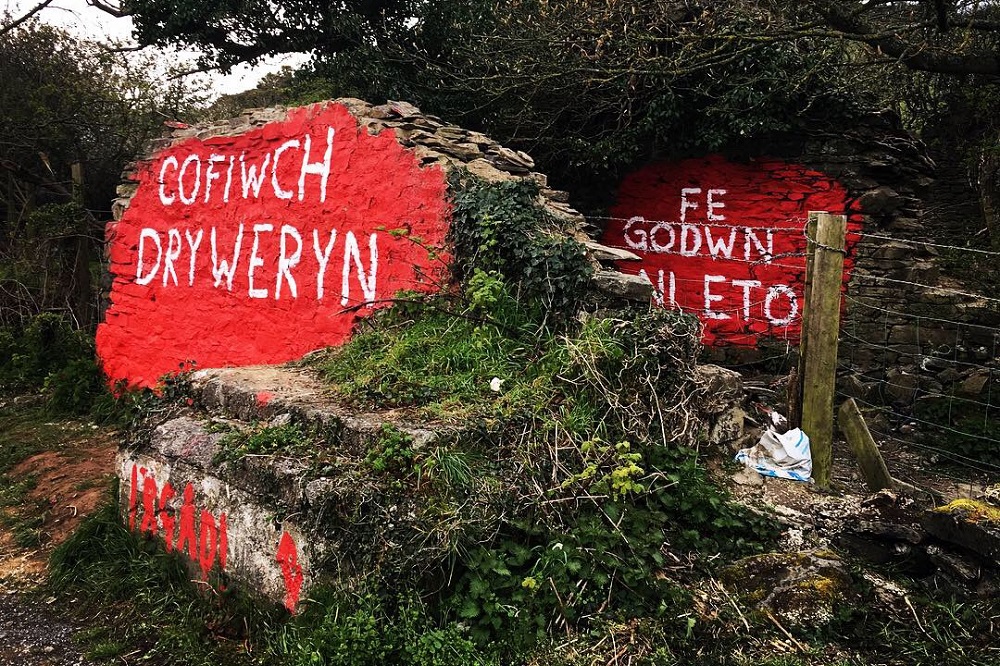Why I’m against protecting the ‘Cofiwch Dryweryn’ wall

Leigh Jones
This past weekend the wall of a ruined cottage in a Ceredigion lay-by baring the symbolic and politically significant slogan, ‘Cofiwch Dryweryn’, was found to have been smashed to pieces – apparently attacked during the night.
The words were painted during the 60s as a reminder to all who passed by of Westminster’s decision to allow the drowning of the village of Capel Celyn to create a reservoir for Liverpool City Council, despite widespread protests from the Welsh public and overwhelming opposition from Welsh MPs.
The famous piece of graffiti, painted over 50 years ago, is therefore important for all of Wales’ inhabitants, regardless of whether they speak the language or not. It’s a reminder that while decisions about Wales are made in Westminster (which, let’s be honest, is another country’s parliament), Welsh MPs will always be outnumbered by their English counterparts and their decisions will not always reflect what is best for the people of Wales.
Since February, when the mural was painted over with the rather less politically-charged slogan ‘Elvis’, there have been calls and even a petition to legally protect the wall and the paint that’s on it.
Some have compared the mural with the Banksy artwork in Port Talbot, which received funding for protection from the Welsh Government almost as soon as it went up.
This comparison is an excellent example of how the state apparatus will always exist to protect the interests of private capital rather than those of the people. The Banksy artwork would be sold for a six-figure sum.
However, although I’m a passionate Welshman, and my politics align with Welsh nationalism, I disagree with calls to protect the wall through legislative means.
In the case of the ‘Cofiwch Dryweryn’ mural, I’d argue that any attempt to preserve a piece of graffiti completely removes its essence and its purpose.
Inspire
Graffiti is a dialogue between people and their environments. As such, their very nature is fluid. In this case, the very act of having to repaint – or in this case, rebuild – the mural reinforces the message that we have not forgotten Tryweryn.
And if graffiti is indeed a reflection of the society that produces it, then the most recent incidents at the ‘Cofiwch Dryweryn’ wall should be a cause for celebration.
Less than 24 hours after being defaced, and partially knocked down, the wall had been restored on both occasions by volunteers. However, it hasn’t been restored by the people who painted it originally, or were active in the political movement in the 60s and 70s, or even by that generation’s children.
Despite being two generations since Welsh political activists took part in that direct action, and the fact that a group of young students took it upon themselves to re-paint the wall and preserve its legacy at a moment’s notice is an incredibly important sign that the future of Wales is in safe hands.
And as we saw this weekend, the partial destruction of the mural inspired people in all parts of Wales to act. ‘Cofiwch Dryweryn’ murals have been painted in Bridgend, Swansea and elsewhere.
There’s one question that people calling for legal protection for the wall have to ask themselves – would the artwork have been reproduced countless times across Wales this weekend if that protection had been in place before this weekend?
Giving it protected status would be denying a new generation of Welsh people the opportunity to engage with it, put their own stamp on it, but most of all perhaps engage with the history of Tryweryn themselves.
If it was protected, that graffiti would become an artefact, frozen in time, the contemporary context completely negated. To leave it unprotected forces us to engage with our surroundings and with what that graffiti means today.
Without the opportunity for them to interact with their own history, and to become a part of it in such an active way, why would the next generation bother to protect the wall and what it represents?
I also believe that there’s a massive contradiction in what is above all an anti-establishment movement asking the state to protect the wall.
Supporting Welsh independence is an inherently radical and revolutionary ideology, but its supporters are asking for support from the very power structures that they are trying to dismantle.
The above is not to say that I believe a crumbling old wall is the best we can do to honour the community that was forced out of their homes, and all that this symbolises. There have been calls for a national monument to the flooding of the Tryweryn valley to be erected, and I agree that it absolutely has to happen.
But the crumbling old mural, and all it symbolises, should remain as it is.
We can’t run Nation.Cymru without your help! If you support the development of an independent Welsh media for the people of Wales, please donate now!
Support our Nation today
For the price of a cup of coffee a month you can help us create an independent, not-for-profit, national news service for the people of Wales, by the people of Wales.




